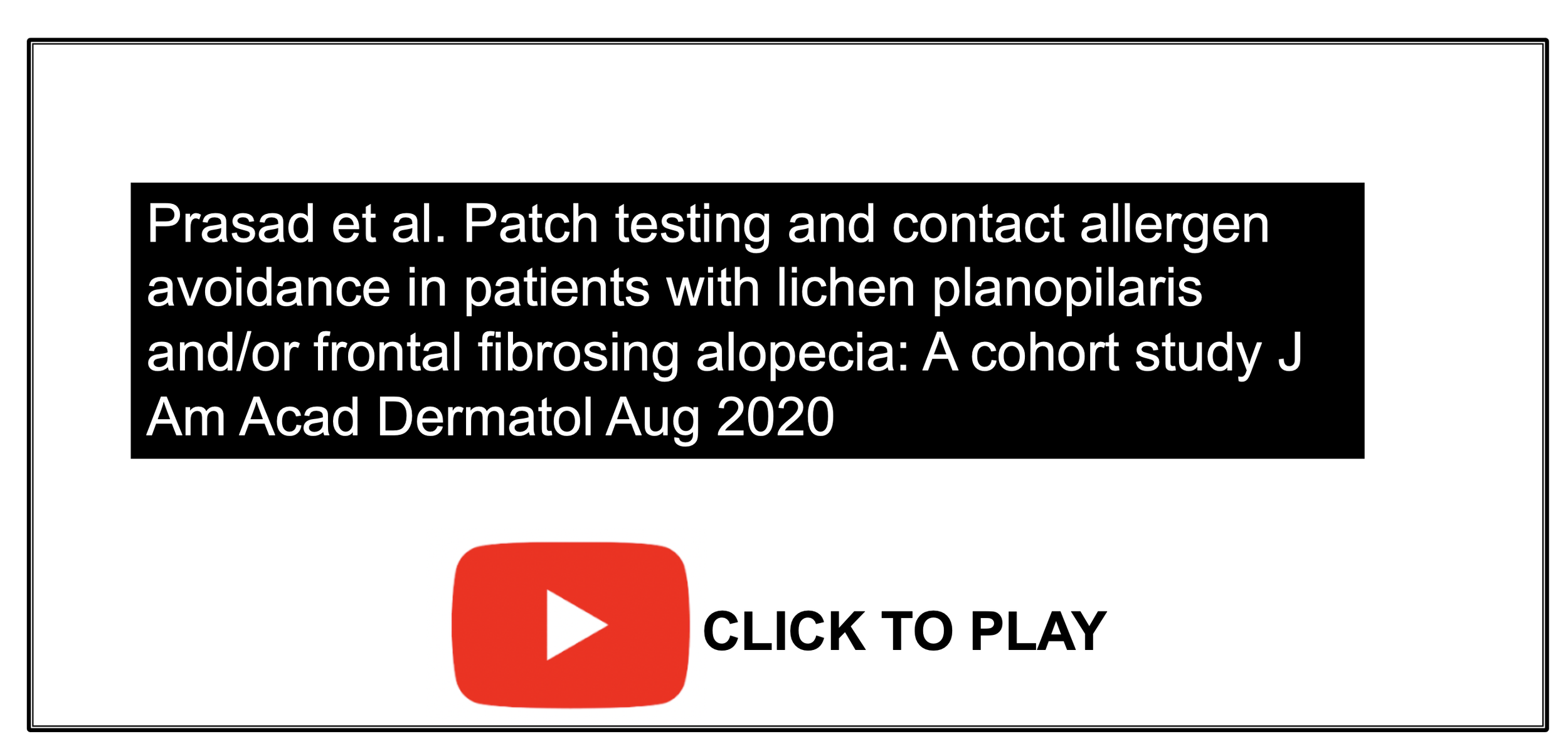Do patients with Lichen Planopilaris and Frontal Fibrosing Alopecia have Relevant Allergies?
A Small Study Points to Relevant Allergens in 100% of Patients and Improvement in 67 % with Allergen Avoidance
The cause of lichen planopilaris and frontal fibrosing alopecia is not known. Some researchers have proposed that allergens may be relevant. I reviewed a study in 2020 by Prasad and colleagues highlighting that fragrance allergens and certain preservatives might be relevant in patients with FFA and LPP. This was a study of patients who underwent patch testing. In addition, what was really important in that Prasad et al study was the finding that patients who avoided relevant allergens have an improvement in their FFA and LPP. You can watch a summary of that study here.
Shtaynberger B et al. 2022
Authors of a new study set out to investigate whether patients with LPP and FFA had relevant contact allergens and if so whether avoiding these allergens could improve their scalp disease. They conducted a retrospective study involving 12 patients with clinically and biopsy proven LPP or FFA and compared data to 30 age-matched patients with spongiotic dermatitis/eczematous dermatitis involving the scalp but without hair disease. All patients had patch testing performed from June 17, 2020, to February 1, 2022.
Results
The study involved a review of 9 patients with LPP and 3 with FFA. There were 30 patients with scalp dermatitis.
All 12 patients (100%) with LPP or FFA had an allergen identified when patch testing was done. In all 12 patients this allergen was felt to be clinically relevant. In patients with scalp dermatitis, 63 % of patients had a clinically relevant allergen. The difference between these two groups was felt to be statistically significant. Propolis was the most prevalent clinically relevant allergen in both the scarring alopecia and scalp dermatitis groups. A positive patch test occurred in 50% of those with scarring alopecia and 20 % of those with scalp dermatitis (20%). Other positive allergens included Fragrance mix in 2 patients (16 %) Methylisothiazolinone in 1 patient (8%) and Iodopropynyl butylcarbamate in 1 patient (8%).
Does allergen avoidance help?
Follow-up data were available for 9 of the 12 patients with scarring alopecia (75%). All of the 9 patients said they adhered to avoiding allergens. 6 of 9 (67%) showed improvement at 6 months. Four had decreased follicular redness or scaling, 2 had improved scalp pain or itch, 2 had stable or improved hair density, and 1 had decreased hair shedding. The authors point out that some of these 6 patients had changes in their treatment plan too so this might have accounted for the improvement. However, there were 2 patients who showed improvement in their scarring alopecia with allergen avoidance alone.
Conclusion
This is another study of the potential role of allergens in LPP and FFA. It is the first study to include an age matched comparative group using identical allergens. The study adds to a growing body of data that suggests that some patients with LPP and FFA just might have an associated contact allergen as a trigger for their condition. The exact role these allergens play is not clear.
The study is small which limits the generalizability of the conclusions. Nevertheless there is signal here that thinking about allergens is relevant to FFA and LPP.
Although this study suggested 100 % of LPP and FFA patients had relevant allergens, not 100 % of my patients have relevant allergens. What is the proportion if truly there is an increased proportion? We don’t know that answer yet.
We often think about patch testing patients who have scalp issues PLUS one or more of the following : rashes ont the face, ears, neck, chest and eyelids. These are what I call the “FENCE” signs. The reality is that many patients with LPP and FFA who have relevant allergens don’t have any of the FENCE signs. Should we patch test all patients with LPP and FFA? Who knows. It’s likely you’ll find allergens but are they relevant? that’s really tough. Avoiding allergens with hypoallergenic shampoos and cosmetic products is probably reasonable and I often recommend hypoallergenic shampoos to my patients with LPP and FFA.
What is propolis anyways?
Propolis is a substance derived from beeswax and also poplar and conifer trees. It’s used in many products including cosmetics, ointments, cough syrups, hair products. Lipsticks, facial creams, mouthwashes, toothpastes, gum, vitamins and honey, varnish used for violins. According to data from the NACDRG about 1.6 to 6% of the population has a positive patch test to propolis. Rates of true propolis allergy are felt to be increasing around the world.
REFERENCES
Shtaynberger B et al. The Prevalence of Type IV Hypersensitivity in Patients With Lichen Planopilaris and Frontal Fibrosing Alopecia. Dermatitis. 2022 Oct 17.
This article was written by Dr. Jeff Donovan, a Canadian and US board certified dermatologist specializing exclusively in hair loss.

